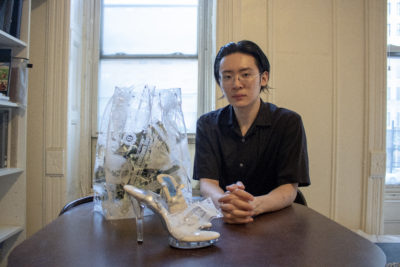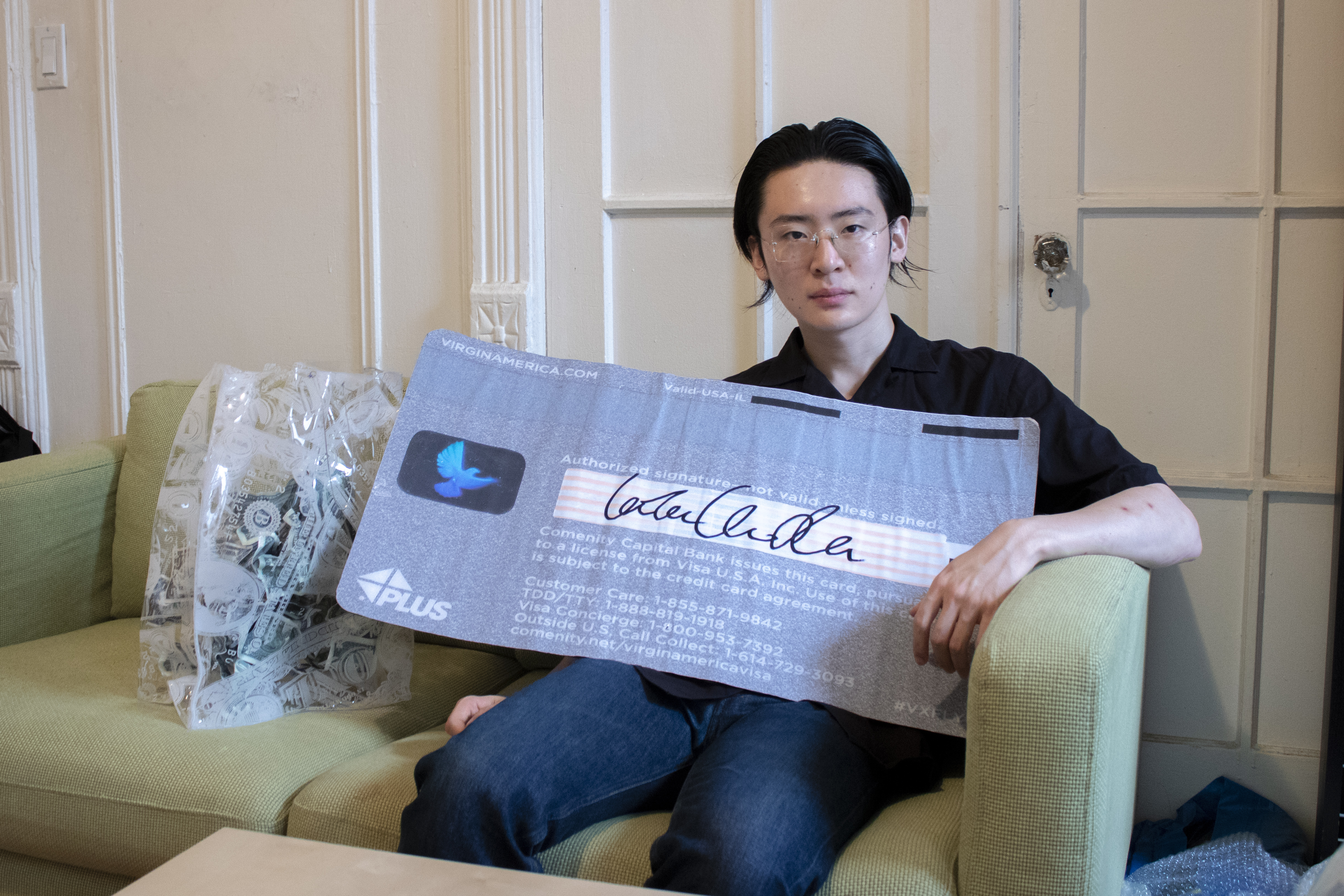After presenting seven looks at the Parsons MFA Spring 2019 Ready-to-Wear show on Sept. 7, jewelry designer Kota Okuda gained attention from several publications, like Garage, Vogue and Paper, and even from Nicki Minaj.
Okuda, 27, is comfortable with precious materials like diamonds and gold, but his thesis took a strong look at the themes of value and money with Karl Marx-inspired commentary on how people create and are controlled by value. His collection included an oversized money clip dress, wallet dress (complete with American Express card) and pieces incorporating U.S. currency.
https://www.instagram.com/p/BnkPwAaliBu/?taken-by=kotaokuda
From idea conception to the runway, this particular project has taken a year–four months for the actual crafting of materials. It was inspired after Okuda read Marx’s reflections on the commodity, which made him reassess how value is translated, especially in materials.
Okuda is very interested in the value society places on materials like 18k gold and diamond. He questions the relationship between cost and value. That was the starting point to think about the creation of his thesis. He has an ongoing interest in money and how people assess worth.
“People create value but the value controls the people,” Okuda said.
With that theory behind him, he created oversized $1 printed paper bills for the dresses, $1 laser-cut and engraved plastic bills for the shoes, and stamped-out dime and penny bras. One of his favorite looks was rejected from the show—a bra made entirely of actual shiny pennies that had a total worth of $2–$1 per breast.
The shoes for all looks were clear, stripper heels that had laser-cut and engraved, small plastic $1 bills attached. The reserved Okuda said that he got the shoes from his friends, who are not strippers, but who love those types of accessories.

The look that Nicki Minaj and her stylist were most interested in was the money clip dress. Okuda went to her hotel and dropped off the look but hasn’t heard anything further. Personally, he doesn’t know Minaj’s work that well.
“I’m not a hip-hop personality, but it’s so funny. It suits for her style,” said Okuda.
Okuda was one of 15 students in Parsons’ MFA Fashion Design and Society program whose thesis work was showcased during New York Fashion Week at Spring Studios. Before enrolling at Parsons, he did a foundation year at Cambridge University in the U.K. and then earned a degree in jewelry design from Central Saint Martins in London. After graduating from CSM, Okuda received an offer to work for Tiffany & Co., but because of his visa, he couldn’t accept and instead chose to continue his studies in New York.
Okuda’s personal style features little to no jewelry. “I don’t like [jewelry] for wearing, even watches. I like glasses, but I really like people wearing jewelry. ” said Okuda.
With his more modest and minimalist aesthetic, it’s not too surprising that his namesake jewelry brand is drastically different from the sometimes overtly sexy work he presented for his thesis. The pieces are more refined, and he uses more classic metal materials like gold and silver. For now, they are only sold at his pop-up shop in the luxury department store Isetan in Tokyo, once each year during the holiday time, and he has no interest in ecommerce.
Despite having customers in Japan, Okuda has heard nothing from Japanese media about his thesis collection. He suspects this is because his collection is not for sale and Japanese consumers are only interested in products that they can possess.
“In Japan, no one cares about the background of design, [or the] artistic element. I also got a response from Hong Kong and Chinese media, but no response from Japan.” said Okuda.
He explained that Japanese brands meant for consumption, like Commes des Garçons and Issey Miyake, have flourished, but it’s difficult to promote avant-garde designs with no commercial purpose.
A causal study of Instagram content from Vogue Japan in the past two weeks, backs up Okada’s theory. During Milan and Paris Fashion Weeks, Vogue Japan’s Instagram featured photos of new trends, runway looks and street style, while American Vogue has peppered their feed of runway looks with content about designers as well. Just based on account content, it seems as if Vogue Japan is more interested in pushing products than is American Vogue.
With one of the largest luxury goods markets in the world, it’s no wonder Japanese people, in Okuda’s eyes, are solely interested in buying fashion and not appreciating it as art within a larger context. According to Deloitte’s “Global Powers of Luxury 2018” study, Japan’s luxury market “is expected to grow further over the next years thanks to rising consumer confidence and purchasing power of the younger generations.”
Although he does not want to sell the pieces that were seen on the runway, Okuda does want to create a product or collection that bridges his thesis work and his own aesthetic.
Contrasting with suspected Japanese consumer behavior, what adds value to something is often the meaning and effort behind it. As we become more transparent shoppers, we want to know the backstory behind the items we purchase and if they do more harm than good–this is why sustainable, ethical and political fashion does well. There is new value in commentary fashion that critiques our society–and we will pay an expensive price for it.
Photo by Orlando Mendiola







